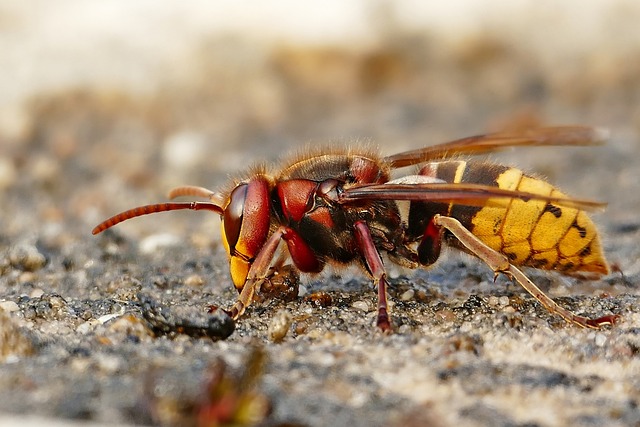Hornets, misunderstood predators of harmful insects, require thoughtful handling due to their organized social structure and aggressive defense of colonies. Safe hornet nest removal involves understanding their diurnal activity patterns (preferring daytime work) and using eco-friendly methods like physical darkness removal or decoy nests. Professional pest control services specialize in non-toxic techniques, ensuring ecosystem preservation while efficiently addressing nests. Preventative measures, such as maintaining a clean environment, planting insect-repelling herbs, and repairing home entry points, aid in avoiding nest formation. For high-risk situations, professional intervention is crucial due to the dangers of DIY removal, especially for sensitive individuals or those with allergies.
Hornets, though beneficial for ecosystems, can pose risks when their nests are nearby human habitats. Understanding their behavior is key to implementing safe and eco-friendly control methods. This article guides you through various strategies, from non-toxic techniques for nest removal to preventive measures inspired by nature. Learn when professional intervention is necessary and discover simple yet effective ways to keep hornets at bay. Master the art of safe hornet nest removal with these comprehensive solutions.
Understanding Hornet Behavior: Key to Safe Removal
Hornets, though often maligned, play a crucial role in our ecosystem as predators of insects that can be harmful to plants and crops. Understanding their behavior is key to safe hornet nest removal. These insects are highly social and live in organized colonies with a queen who oversees reproduction and worker hornets responsible for foraging, building the nest, and defending the colony. Knowing this hierarchical structure helps in planning safe removal methods.
During the day, hornets are active and tend to be less aggressive. However, when their nests are threatened, they can become highly defensive. To ensure safe hornet nest removal, it’s best to observe their behavior patterns and timing. Nighttime is generally safer as most hornets return to their nests after dark. Moreover, professional pest control services specializing in eco-friendly methods can provide the necessary expertise for safely removing hornet nests while minimizing disruption to local ecosystems.
Non-Toxic Methods for Hornet Nest Control
When it comes to dealing with hornet nests, there are non-toxic methods that offer a safer alternative to chemical treatments. These eco-friendly solutions are ideal for those who want to avoid harmful pesticides and still effectively manage hornet populations. One such method is physical removal, which involves carefully dismantling the nest under the cover of darkness when activity is at its lowest. Wearing protective gear, including gloves and long sleeves, trained professionals can meticulously disassemble the nest, ensuring minimal disruption to the surrounding ecosystem.
Another safe hornet nest removal technique leverages the natural behavior of hornets themselves. By using decoy nests, which are false attractions designed to lure hornets away from their actual nest, it is possible to redirect their activity while leaving the original nest undisturbed. This method not only provides a humane and chemical-free approach but also helps maintain the balance of local wildlife and insect populations.
Professional Intervention: When and How to Call Experts
If a hornet nest has taken up residence in or around your property and poses a significant risk to safety, it’s time to consider professional intervention for safe hornet nest removal. While DIY methods can be appealing, attempting to remove a large hornet nest yourself can be extremely dangerous. Hornets are aggressive protectors of their colonies, and stings can lead to severe reactions in sensitive individuals or those with allergies.
Professional exterminators have the necessary equipment and expertise to safely and effectively remove hornet nests. They use specialized protective gear and tools designed for these situations, minimizing the risk to themselves and your family. When calling experts for safe hornet nest removal, be prepared to provide detailed information about the nest’s location, size, and any known entry points. This helps professionals plan a strategic approach to ensure the job is done safely and efficiently.
Preventive Measures: Keeping Hornets at Bay Naturally
Preventing hornets from establishing nests in the first place is a key aspect of safe hornet nest removal. This can be achieved through natural means and some simple lifestyle adjustments. One effective strategy is to maintain a clean and clutter-free environment, especially around your home’s entry points and windows. Hornets are attracted to sweet scents and fermenting foods, so eliminating these from your outdoor spaces can deter them. Regularly cleaning your yard, removing fruit from trees, and securing trash cans with tight lids will make your property less appealing to hornets.
Planting certain herbs and flowers known for their insect-repelling properties is another natural preventive measure. Peppermint, lemongrass, lavender, and marigolds are popular choices known to ward off hornets. Strategically placing potted plants around your home’s perimeter can create a natural barrier against these insects. Additionally, repairing any cracks or gaps in walls, doors, and windows ensures that hornets have fewer opportunities to enter your living spaces, promoting safe hornet nest removal by making your home less accessible to them.
When it comes to safe hornet nest removal, understanding their behavior and employing eco-friendly methods are key. If natural solutions prove insufficient, professional intervention can effectively address persistent issues. By combining these approaches with preventive measures like natural repellents, we can coexist harmoniously with these insects while ensuring our safety. Remember, a well-informed strategy tailored to your situation is the best way to achieve safe hornet nest removal.
